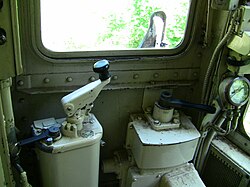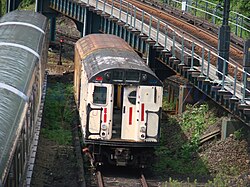R17 (New York City Subway car)
| R17 | |
|---|---|
Westinghouse H2C | |
| Track gauge | 4 ft 8+1⁄2 in (1,435 mm) |
The R17 was a New York City Subway car model built by the St. Louis Car Company in 1954 for the IRT A Division. A total of 400 cars were built, arranged as single units. Two versions were manufactured: Westinghouse (WH)-powered cars and General Electric (GE)-powered cars.
The first R17s entered service on October 10, 1955. Originally painted maroon red, the R17s subsequently received several different paint schemes, including bright red, platinum mist/blue, or plain white. The R17s were replaced by the R62As in the 1980s, and the final train of R17s ran on February 29, 1988. Some R17 cars were saved for various purposes, but most were scrapped.
Description
The R17s were numbered 6500–6899. They were one of three car classes purchased in the mid-1950s by the
There were two versions of the R17:
Cars 6800–6809 were factory equipped with air conditioning when delivered.[2] However, the air conditioning experiment was considered a failure, and the cars were refitted with standard axiflow fans between 1962 and 1964.
As delivered, R17s came with low-running lights and very comfortable foam rubber seats. In 1957, sealed beam

While the cars received the fox red paint scheme like other cars that would go on to be later known as "
The major identifying characteristics of the R17 can all be found in its windows. These include the circular windows on the car end doors, similar to those found on the
The R17, like many older New York City Subway cars built for the A Division, also features two sets of mid-car body passenger windows on each side. Normally arranged in two pairs of three on the
Car 6812 was repainted with a gold exterior scheme with a view of being used in the Fifth Avenue Association's 50th Anniversary Parade; however, the car was withdrawn in favor of R22 7526.
Car 6552 received a speckled green interior paint scheme during the early 60s.
History
The first train of R17s was placed in service on the 6 train on October 10, 1955. All 400 cars were delivered by January 1956. In 1959–60, with the delivery of the R26s and R28s and their being placed in 6 service, the G.E. equipped cars were transferred to the West Side Lines and became part of the R21/22 fleet. On November 1, 1962, fifty R17s (#s 6500–6549) were transferred from the Mainline IRT to the 7, allowing for ten-car operation on that route. Shortly thereafter, an additional thirty cars (6550–6577, 6580, 6581) were similarly transferred to augment this service.[3]
The R17s were delivered in a maroon paint scheme. Some were repainted bright red ("tartar red") in the late 1960s. All cars received the TA sliver/blue paint job starting in 1970. In the early 1980s, they were painted plain white, and eventually, 16 cars were repainted fox red for
During the course of their careers, two cars (6673 and 6786) were wrecked in 1957 as a result of a collision near
Retirement

The R17s were replaced by the R62As, as they had reached the end of their planned service lives. The final train of R17s ran on February 29, 1988, in the 42nd St. Shuttle service.
The majority of the remainder of the fleet was scrapped, but some R17 cars were saved for various purposes throughout the New York City Subway system, including:
- Car 6609 – restored in 1976 and displayed at the New York Transit Museum in Brooklyn. It is fully operational and runs periodically on museum-sponsored "Nostalgia Trains", specifically on the Train of Many Colors.
- Car 6688 – preserved at the Shore Line Trolley Museum in East Haven, Connecticut. It is fully operational, though modified with trolley poles, and runs frequently during the summer months for rapid transit themed programming.
- Cars 6835 and 6899 survive as work cars, converted to R71 hose reach cars, and overhauled under the R159 program.[5]
Car 6895 (renumbered to 36895) is currently in storage at
Car 6762 was converted to an R71 rider car after retirement, but was replaced with R161s (R33s converted into rider cars) in the mid-2000s and eventually reefed.[7]
Cars 6813 and 6850 were converted to R123 continuous welded rail holder cars for set DCR and overhauled under the R128 program,[8] but were replaced with R157 flat cars in the 2010s and eventually scrapped.[9]
In film
Cars 6671 and 6609 were featured at Grand Central Terminal in the 1971 film The French Connection in a scene where Gene Hackman's character is tailing a heroin smuggler. At that time, the cars were painted in the MTA platinum mist/blue band livery.
R17s can be seen on the 42nd Street Shuttle in Ron Howard's Night Shift (1982).
White painted (though clean) R17s on the Shuttle appear in a scene of
The interior of a repainted red R17 operating on the
A decommissioned R17 is featured in the film Mimic as the escape vehicle for the film's protagonists.
Car 6688, which belongs to the Shore Line Trolley Museum, appears in the 2014 film The Amazing Spider-Man 2 as well as the 2019 film Joker.
References
- ISBN 0-8018-6886-6, pp. 203 - 210
- ISSN 0362-4331. Retrieved June 20, 2016.
- ^ "R17s to the Flushing Line". New York Division Bulletin. Electric Railroaders' Association. December 1962.
- ^ "Showing Image 114716". nycsubway.org.
- ^ http://www.nycsubway.org/wiki/R-71_Reach_Cars
- ^ R17 in Concourse Yard http://nycsubway.org/perl/show?57790
- http://nycsubway.org/wiki/R-71_Rider_Cars
- ^ "www.nycsubway.org".
- ^ https://new.mta.info/document/25251 page 140
External links
![]() Media related to R17 (New York City Subway car) at Wikimedia Commons
Media related to R17 (New York City Subway car) at Wikimedia Commons
